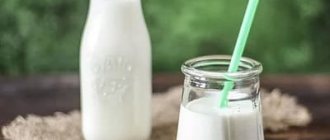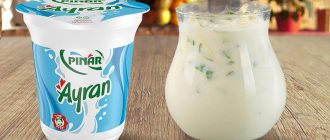The goal is perfect health
The idea of using low-fat dairy products came to American scientists in the last century. Then a direct relationship was established between a high fat diet and the development of cardiovascular diseases.
This event made significant adjustments to the diet of ordinary citizens and contributed to the creation of a huge industry for the production of low-fat dairy products. Today, the ability to get rid of fat in cottage cheese or milk has reached unprecedented heights, but society is faced with a new problem.
Regular consumption of low-fat foods leads to serious metabolic disorders.
Disappointing research results show that future generations will fall victim to this low-fat diet. This is clearly illustrated by American society, where up to 50% of the entire population of the country faces the problem of impaired metabolism. Moreover, not only adults, but also children are susceptible to such diseases.
Of course, morbid obesity cannot be blamed solely on low-fat dairy products. However, they significantly contribute to disrupting the process of fat accumulation in the body.
In pursuit of taste
Initially, the idea of reducing fat content had good intentions and made life easier for people suffering from diseases of the cardiovascular system and diabetes
. All that was necessary was to separate the milk. But the final result did not give the desired result.
The fat content did decrease, but the taste suffered. Which was unthinkable in a situation of general interest in a new and “healthy” diet.
- Having lost fat, the product became bland and inexpressive.
- The pleasant aroma disappeared.
- The consistency became uneven.
- The shelf life was significantly reduced.
But demand creates supply, and a solution was found in the form of various food additives and stabilizers
. They made it possible to preserve and sometimes improve the presentation and taste of low-fat products.
Natural and beneficial fats for the body began to be replaced:
- Refined sugar or its substitute.
- Starch.
- Stabilizers.
- Preservatives.
- Flavorings
.
Regular salt in increased quantities helps solve the taste problem in low-fat cheese.
This can become a serious health problem, since the daily salt requirement for an adult is only 5g. In cheese according to the classic recipe, 100g of product can contain from 1.5 to 3.5g, and in low-fat cheeses this value can be increased. These additives themselves cannot cause damage to the body, but their presence increases the amount of fast carbohydrates
. Which leads to weight gain, water retention in the body and other consequences.
So why, when choosing between dairy products with 9% and 0% fat, will the majority still prefer the second option?
List of dairy and fermented milk products. Classification of dairy products
1. Milk separation products.
Separation in industry refers to the separation of some structural components of milk from others. The most famous and widespread milk separation products are:
- cream – milk fats separated from the main mass. Typically, in raw milk, the cream collects at the top of the vessel due to its lower density;
- butter - whipped cream. In terms of its composition, butter is no different from cream. It’s just that in cream, fat is dissolved in liquid, and in butter, on the contrary, liquid is dissolved in fat. Therefore, butter is harder and denser than cream;
- whey used in the making of cheeses and in the preparation of many homemade dishes. As a rule, it remains after curdling and straining the milk. This, in fact, is the very liquid fraction of milk in which proteins and fats dissolve.
The main distinctive feature of separation products is their preservation of the properties of milk. After all, no chemical reactions occur here. And if such reactions take place in milk, then fermented milk products are obtained.
2. Fermented milk products.
After most of the sugars in milk have been processed by a whole army of lactic acid bacteria, the milk sours. But this does not mean the loss of its nutritional properties. On the contrary, fermented milk products are digested much easier by many and, as a result, are much more valuable for the majority of the population.
The most famous fermented milk products are:
- curdled milk is the simplest product, which is simply sour milk without any additives. This is the oldest fermented milk product known to man;
- cottage cheese . In fact, cottage cheese is the same curdled milk from which the liquid part of milk - whey - is squeezed.
- cheese – a dairy product obtained after heat treatment of cottage cheese;
- sour cream - sour cream. As a rule, for better souring of heavy cream, a special starter is added to it. Although even without it the sour cream turns out excellent;
- kefir and yogurt are closely related products obtained by fermenting milk from which the cream has previously been removed. Only when preparing kefir, a whole set of bacteria, yeast and rods is used, and when producing yogurt, the whole thing is entrusted to ordinary lactic acid bacteria;
- Ryazhenka is a fermentation product of baked milk;
- ayran - yogurt to which salt is added instead of sweeteners and flavorings;
- kumis and shubat are curdled milk made from mare’s and camel’s milk, respectively.
The illusion of the right choice
The reason for the popularity of low-fat products lies in their availability and deceptive simplicity.
There is no need to spend time creating a balanced diet, taking into account calorie content and the ratio of proteins, fats and carbohydrates. After all, a ready-made solution is already waiting for us on store shelves. Low-fat kefir gives a false sense of control
. After all, nothing terrible happened and one serving of the drink is unlikely to affect your figure. However, it has been proven that this line of thinking often leads to the opposite effect. So much so that daily calorie content increases by an average of 250 kcal. This is facilitated by inner peace and the illusion of making the right choice, which often leads to an increase in portions.
Obvious harm
It is difficult to overestimate the impact of low-fat foods.
And if the diet is not balanced, this can lead to serious consequences. After all, fats are an irreplaceable “building material” that helps maintain immunity at the cellular level. The first thing the body faces when it switches to a low-fat diet is a lack of these same fats.
. This situation disrupts the natural course of events. The body begins to actively accumulate incoming lipids, which leads to fat deposits that are forced from a health point of view.
After all, fats are not only a source of calories, but also a valuable material necessary for brain function, stability of the hormonal system, etc. As a result, excess weight, problems with metabolism and subsequent disorders of the endocrine system.
Hunger is another important aspect. Low-fat foods do not cope with their main task and make you feel hungry more than usual.
. This problem is especially relevant for strict and unbalanced diets.
Lack of saturation and the illusion of zero fat content leads a person to unwanted overeating. Of course, counting calories can prevent this, but it doesn't make you feel any less hungry.
Fats are replaced by carbohydrates
. This is especially true for yoghurts and other sweet dairy products. Without sugar, they would be tasteless and unlikely to gain universal acceptance. Therefore, to create optimal consistency and taste, modified starch, sugar and other carbohydrates are added to the composition, which do not contribute to the health and beauty of the figure.
In addition, we must not forget about various food additives and flavor enhancers.
It has been established that a decrease in healthy fats also leads to a decline in psychological health. Thus, lovers of 1% fat content in dairy products are more prone to depression and increased irritability.
Saturated fats aren't just for dairy products
The main reason why global organizations recommend choosing low-fat or low-fat foods is saturated fat. The fattier the dairy product, the higher the proportion of saturated fats. Namely, these fats can increase cholesterol levels in the blood.
However, saturated fat is not only found in dairy products. Therefore, low-fat yogurt will not help you if you eat, for example, fatty meat, fast food, butter and coconut oil, as well as store-bought baked goods.
Harm of sweetener
Another problem with many low-fat dairy products is the sugar substitute.
It would seem that its presence solves one of the problems associated with high carbohydrate and calorie content. But here, too, everything is rather ambiguous. If a person has eaten, albeit low-fat, but high-calorie yogurt with refined sugar, the endocrine system receives a command to process incoming carbohydrates
. The sweetener disrupts this process, and the “deceived” body tries to catch up.
This leads to increased appetite and cravings for simple carbohydrates. This in itself does not contribute to weight gain, but this condition significantly worsens the overall quality of life and makes you obsess over the feeling of hunger.
How to choose fermented milk products?
Representative of Rospotrebnadzor Ekaterina Golovkova answered these and other questions for the Food Formula program. – What is the “official” definition of kefir and yogurt?
– According to TRTS 033/2013 “On the safety of milk and dairy products”: kefir is a fermented milk product produced by mixed (lactic acid and alcohol) fermentation using a starter prepared with kefir grains, without the addition of pure cultures of lactic acid microorganisms and yeast; yogurt is a fermented milk product with a high content of nonfat milk solids, produced using starter microorganisms (thermophilic lactic acid streptococci and Bulgarian lactic acid bacillus).
Regular yogurt contains three to five types of beneficial microorganisms. There are more of them in kefir - up to 20. The “kefir grain” itself is a symbiosis of several types of microorganisms: lactic acid streptococci and rods, acetic acid bacteria and yeast. Yogurt is also obtained by fermenting whole milk, but a special “microbiological kit” is used for this - Lactobacillus bulgaricus (Bulgarian bacillus) and Streptococcus thermophilus (thermophilic streptococcus). Yogurt differs from kefir in consistency and the absence of ethanol.
– How often do Rospotrebnadzor experts detect falsified and counterfeit products in the dairy industry? Is there data for last year?
– In 2021, Rospotrebnadzor examined about 254 thousand samples of dairy products based on sanitary-chemical, microbiological and physico-chemical indicators. The proportion of samples that do not meet the standards for microbiological indicators for 2020 was 3.64%. According to physical and chemical indicators characterizing product quality, 4.7% of samples did not meet regulatory requirements. Rospotrebnadzor specialists, following the issued orders, removed 365 tons of milk and dairy products from circulation.
– What should a consumer do if he bought low-quality kefir or yogurt and lost the receipt?
– If you purchased low-quality products and discovered this on the day of sale, you can return it to the store in accordance with Article 18 of the Law “On Protection of Consumer Rights”. The absence of a receipt is not a basis for refusing to accept substandard products. The buyer has the right to refer to other evidence. For example, recordings from store video cameras, the presence of witnesses to the purchase.
– How are kefir and yoghurts most often counterfeited: what kind of counterfeits did Rospotrebnadzor specialists find?
– Kefir is adulterated by using milk powder, starter cultures containing direct addition of dry concentrate containing lactic acid bacteria. This is no longer a harmonious combination of kefir grains and bacteria, but “dried” microorganisms. The live bacteria that are written about on the packaging are simply not there. Bacteria that have such a beneficial effect on the body live no longer than three days.
Preservatives, dyes and flavor enhancers are added to yogurt to extend its shelf life, and it becomes a dessert. Instead of fruits, synthetic dyes and starch are often added, which can cause allergies in children and provoke liver disease. The label may not indicate any preservatives or colorings used.
– What signs indicate that kefir and yogurt are of poor quality?
– Normally, the color of kefir is white, without shades. The main thing is the smell, which should not be sharp, and the taste, which should not be bitter or, conversely, sweet. Good kefir always gives off a slight sourness. Too sour kefir is bad; storage rules may have been violated. The color of yogurt is determined by the color of the fruits it contains. If there are none, then it must be white.
Kefir and yogurt are extremely sensitive products, as they are made from live starter cultures, and any violations during transportation and storage can cause irreversible processes. The consumer should traditionally pay attention to the packaging, its absence of swelling, integrity, and also choose trusted manufacturers who value their reputation, and be wary of incredibly cheap goods.
– What should you pay attention to when purchasing? What is the shelf life of natural kefir and yogurt?
– The shelf life of natural kefir on average reaches 10–14 days. But it depends on the packaging: in glass bottles it can be stored for 36 hours, and in polymer containers - 72 hours. If the packaging indicates that its shelf life is a month or more, then it is probably made using artificial emulsifiers and vegetable fats. Typically, the expiration date and storage conditions are set by the manufacturer. Yogurt with live bacteria can be stored for no more than seven days. Some manufacturers increase the shelf life of such yoghurts to two weeks, which most often indicates the manufacturer’s dishonesty.
– How to check the quality of a purchased product at home or in a store?
– Natural kefir should consist only of pasteurized milk and a starter culture of live bacteria. If you want to choose a product with maximum beneficial properties, take kefir with 2.5–3.2% fat content. Low-fat kefir does not contain fat and fat-soluble vitamins. For example, vitamin D in the absence of fat molecules is not absorbed.
The closer to the point of sale the kefir is produced, the better. There are two types of kefir according to the production method - thermostatic and tank. These products only have a difference in consistency: the thermostatic one is more delicate and soft. Natural yogurt consists of natural milk and a starter containing cultures of Bulgarian bacillus and thermophilic streptococcus and added milk powder, fruit or vegetable components, spices, sugar, natural flavors and thickeners (pectin, agar, gelatin).
The main criterion that determines the naturalness of yogurt in Russia is the concentration of lactic acid bacteria of at least 107 at the end of the shelf life.
– How to properly store yogurt and kefir?
– It is best to store kefir and yogurt on the top shelf of the refrigerator at a temperature of +2 to +6 °C. The expiration date is usually indicated on the product packaging. On average - from 7 to 14 days. It is better to store it in the same packaging in which the product was purchased. You should not freeze the product; kefir and yogurt will quickly deteriorate and lose their beneficial properties. Opened kefir and yogurt can be stored at a temperature no higher than 10 °C for no more than 4–6 hours. It is better to consume the product immediately after opening.
Benefits of low-fat dairy products
Despite all the controversial issues in the use of this category of products, there are several positive aspects.
Low-fat yoghurts, kefir and milk can indeed be lower in calories than regular ones.
This is especially useful when following strict diets, when every percentage of fat and carbohydrates counts. This statement can only be applied to natural products with the appropriate composition. A small percentage of fat does not increase the level of “bad” cholesterol, which is valuable in the prevention of cardiovascular diseases. However, this does not exclude the disorders described above, which can lead to obesity and new problems.
Low-fat dairy products will be useful for people suffering from hypertension and as a prevention of atherosclerosis
.
Powdered skim milk alleviates gastritis with high acidity, heartburn and other diseases of the digestive system
. Thanks to its gentle effect on the walls of the stomach, relieving inflammation and irritation of the mucous membranes. It will be useful for some kidney pathologies, acting as a diuretic and at the same time restoring the body’s vitamin and mineral reserves.
However, in case of pancreatitis in the acute phase, gastritis with low acidity and the presence of kidney stones, powdered milk should not be consumed!
In other cases, the constant use of such products is not advisable. Since low-fat foods do not provide the necessary saturation of the body with nutrients.
As an example, can low-fat cottage cheese be used instead of a product with regular fat content? This product is famous for its protein, phosphorus, calcium, etc. content.
So, per 100g of cottage cheese there is about 95mg of calcium, the absorption of which will require approximately 9.5mg of fat
. This, in turn, meets the characteristics of cottage cheese with 9% fat content. It is not advisable to consume cottage cheese below 5%, since the resulting calcium simply cannot be absorbed in the body.
The final decision about whether to introduce low-fat dairy products is made by everyone independently. But, as you know, the best solution is moderation in everything
. And if the consumption of low-fat dairy products is dictated by medical necessity, then you should treat this with maximum responsibility, carefully monitoring the vitamin and mineral balance and nutritional balance.
Why are low-fat foods harmful?
Such elements of your diet taste good and give an excellent boost of energy. But low-fat foods lack fiber, proteins, minerals and vitamins. In addition, in order to preserve taste while removing fats, sucrose and starch are added to them. This way the food loses fat and gains more carbohydrates.
What is the right thing to do in this situation? If you are overweight or have high blood cholesterol levels, you should limit the amount of fat in your menu. You can eat foods low in fat or without this harmful substance:
- low-fat cheese,
- skim milk,
- light mayonnaise,
- salad dressing.
But don't get too carried away with such substitutes. Initially, you should eliminate really fatty foods from your diet:
- lamb,
- beef,
- meat snacks,
- cheeses,
- whole milk,
- potato chips,
- ice cream.
Next, you need to start changing the cooking method itself. Replace frying in oil with grilling, boiling in water or steaming. It is also extremely important to eat natural foods. The less processed it is, the healthier, more nutritious it is and contains less sugar and fat.
Learn to read labels correctly! Most often, manufacturers use a trick in which the packaging indicates the amount of fat in one unit of the product (for example, in one cookie). People who want to lose weight or stay in shape, having seen magical numbers, as if under hypnosis, do not see the true indicators and proper nutrition becomes the way of their life.
Therefore, to avoid such a situation, you should know:
- In a low-fat product, fat is no more than half a gram per unit, and a product with a low percentage of fat content or no fat at all - 3 g or less. “Light” products have 25% less fat than regular ones;
- the total carbohydrate content (sucrose, starch) is indicative;
- be able to distinguish between the weight of the package and the weight in relation to which the amount of fat is indicated.











